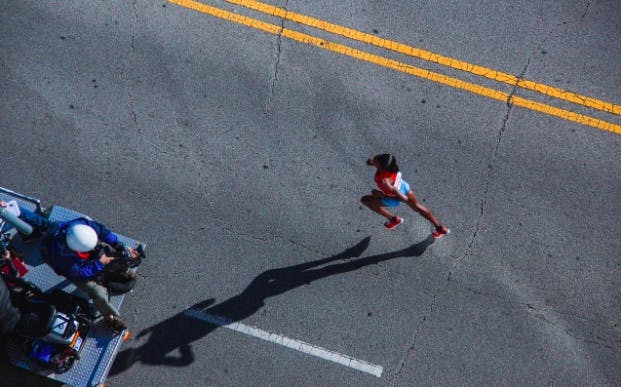How to Breathe When Running
February 28th 2021
According to exercise data, 60 million Americans ran, jogged, or went trail running in 2017. The same statistics project that in 2019 nearly 3.3 million American households will take part in running a marathon event in the country.
If you rank yourself among those 60 million, there's science behind the training that allows you to run for longer and better. At SportMe, we are dedicated to providing you with the tools and skills to maximize the benefits you get from running - and we know that in order to do this, you need to maintain good form. While it seems simple on the surface, running is actually complex. It's more than throwing one leg in front of the other. It's about syncing up the different parts of the body to allow for max efficiency and speed.
The most difficult part of running is getting your breathing right. Breathing incorrectly can have a major adverse effect on your endurance, and thus your performance. Part of that form is your breathwork.
Related: 20 Tips for Long Distance Running
The Importance of Breath Control While Running
While it may seem like a small part of running, proper breath control is actually hugely important. This is so for a few different reasons.
For one, proper breath control ensures that you're breathing in adequate amounts of oxygen. Failure to breathe in adequate amounts of oxygen can lead to feelings of weakness and lightheadedness. When a runner starts feeling weak or lightheaded, he or she feels inclined to stop running.
In addition, proper breathing keeps facial stress to a minimum. The less stress the body is experiencing, the easier running becomes.
Proper breathing is also important for rhythmic reasons. If your breath is out of time with the movement of your body, you'll be in a constant state of mental and physical stress.
The Science Behind Running for Longer
The speed and effectiveness of your run depend on your breathing methods.
Everyone around the world is still reeling from watching Eliud Kipchoge run a 26.2-mile marathon in under two hours. While few people can reach his impressive distance and speed even with rigorous training, there is a lot to learn from his breathing techniques.
You see, Kenyan marathon and long-distance runners have a training camp in the Rift Valley region of the country known as “Iten, home of the champions”.
The camp is 2400 meters above sea level, where oxygen levels are extremely low. Kenyan athletes have learned to run with low oxygen levels in order to work on their breathing rhythm. As a result, they hardly run out of breath when they compete in international races in sea level regions because of their superior deep breathing technique.
Breathing is one of the keys to great running.
How to Breathe When Running

Photo by djedj on Pixabay
We might not run in Iten, but there are still ways you can improve your breathing as you run.
Proper Breathing for Long Distance Runs
The manner of your breathing should vary based on the type of running that you're doing. As such, long-distance runs necessitate a different type of breathing than do sprints.
When running long distances, you're moving at low or intermediate speeds. As such, you should be aiming for a 3:3 or 2:2 step ratio. Low speeds get a 3:3 ratio while intermediate speeds get a 2:2 ratio.
So, when moving at low speeds, your breath should be drawn in over the span of 3 steps. It should then be let out over the span of the next 3 steps. This should happen throughout the entirety of the run.
When moving at intermediate speeds, your breath should be drawn in over the span of 2 steps. It should then be let out over the span of the next 2 steps. Again, this should happen continuously for the duration of the run.
How to Breathe When Running Sprints
When sprinting, you're moving as fast as you possibly can. So, as you might expect, you need to take breaths at a much faster pace.
Generally speaking, this commands a 1:1 step ratio. You breathe in for the duration of 1 step and then breathe out for the duration of 1 step, continuing this pattern for the entirety of the running session.
More Breathing Techniques for Running

Photo by baranq-stock.adobe.com
Diaphragm Breathing
One of the keys to breathing while running is to breathe from your diaphragm. Your diaphragm is located between your abdominal muscles and the thoracic cavity.
When you breathe from your diaphragm, your stomach expands and then contracts when the breath is let out. This form of breathing is sometimes referred to as "breathing from your stomach" or "deep breathing".
Diaphragm breathing is important during runs as it allows you to pull in as much oxygen as possible with each breath. The more oxygen you're pulling in, the greater your endurance, both physically and mentally.
Rhythmic Breathing
Rhythmic breathing is the practice of breathing, well, in rhythm. It includes syncing up your breath with the rest of your body's movements and then repeating it in the exact same manner over and over again.
The opposite of rhythmic breathing would be inconsistent breathing, a practice in which each inhalation or exhalation lasts a different length than the one previous to it.
When running, the best way to practice rhythmic breathing is by counting footsteps. For instance, you might draw in a breath for the amount of time it takes you to take 3 steps, and then let out a breath for the amount of time that it takes you to take 3 more steps.
Double Breathing
Another breathing technique you might consider is double breathing. This is a technique wherein you double up on the number of breaths that you're taking. So, while you might usually take 1 breath over the span of 4 steps, double breathing would require you to take 2 breaths over the span of 4 steps.
This technique can come in handy during long runs as it allows you to balance your breathing during acceleration or deceleration. If your usual breathing rhythm begins to feel uncomfortable, you can switch to double breathing as a means of staving off the discomfort. Once you feel comfortable again, you can return to your initial cadence.
Steady Breathing
Steady breathing refers to the concept of maintaining your breathing cadence. This is important during runs, as it helps to keep your body in sync. When your body gets out of sync, it places tension on both itself and the mind, resulting in both physical and mental discomfort.
The key to steady breathing is to never break the cadence. You can speed up at times, and slow down at times, but never change the time signature of your breath. Remain in steady 4:4 time from the moment you start until the moment you finish.
Don’t take shallow breaths
Shallow breathing is the main culprit when it comes to runners having difficulty with running, especially beginners. Shallow breathing does not deliver enough oxygen to your lungs. As a result, oxygen is distributed poorly and inefficiently to your muscles.
Less oxygen culminates in buildup of lactic acid, which makes muscles sore and painful. This type of breathing also results in the dreaded side stitch.
So instead, train yourself to take deep breaths so that your lungs are at full capacity at all times. This allows you to retain enough to distribute to your muscles as you run. With enough oxygen, your muscles produce ATP, an organic chemical responsible for muscle contractions without pain.
Learn how SportMe works and sign up here.
Use Mouth Breathing
Breathing through the mouth is best when running because it allows you to take in a lot more air than the nose. The important thing to remember when running is that you need copious amounts of oxygen. Remember, anything that prevents you from belly deep inhalation will hamper your overall success.
Proponents for nose breathing during running argue that breathing through the nose allows you to filter the air, ultimately warming the air as it passes through the nostrils. This is true.
However, as you run, you place your body under stress. While in this state, it needs the maximum intake of oxygen possible to mitigate the stressful symptoms of running. Breathing through the nose won’t deliver as much oxygen, and your biggest concern while running should be whether your lungs are filled to capacity (and not the warmth of your breath).
Here’s an experiment:
Increase the intensity of your run and try to breathe through your nose for a while. Give it five minutes of nose-breathing at a fast tempo. Are you getting tired faster? Can you hear pounding in your ears?
That's your body telling you to breathe through your mouth and give it enough oxygen before it shuts down.
Three Incremental Breathing Steps

Photo by Pexels on Pixabay
Start easy
Start easy, and ramp up - nothing causes a lack of oxygen quicker than moving faster than your body can adapt.
If you are a complete newbie, then stay with this pace for a few weeks before increasing the intensity. For seasoned runners, use this time as the warm-up portion of your routine before continuing with more intensity. This basic running hack is crucial for any runner because it sets the tempo for rhythmic breathing.
Shoot for three steps while inhaling and three steps while exhaling.
Related: Get to Know Elite Runner YiOu Wang
Increase tempo
This is the second phase of your run and it’s a bit faster in tempo. The intensity is medium, so your body now requires more focus and a better breathing rhythm. You can’t hold on to the 3:3 steps formula, so gradually switch to the 2:2 step - inhale for every two steps you take and exhale for the next two steps.
This formula helps you attain a steady pace as you bring your running in tandem with your breathing. Some people prefer to skip the easy start section above, and jump straight into this pace of running.
If that sounds like you, it’s recommended that you first walk using this breathing formula to warm up before running.
If you feel the intensity you've started with is too much, slow it down to the above easy start tempo to give your body a chance to recover.
Learn how SportMe works and sign up here.
Set a marathon pace

Photo by skeeze on Pixabay
The marathon pace is the most high intensity, requiring you to put all your strength into this last section. The breathing formula is 1:1, meaning you inhale and exhale with each step. Keep your breathing steady with this breathing count both uphill and downhill so that your diaphragm can work as it’s supposed to.
Done right? Now you're flying.
It’s dangerous to start running at this pace without using either one of the above formulas to warm up. Even seasoned runners can’t go from zero to 100. It increases your risk of injury and puts immense strain on your muscles and joints.
Conclusion

Photo by Tom Wheatley on Unsplash
Most of the world’s impressive long-distance runners have one thing in common. They train in high altitude areas to practice their breathing and push their bodies. You have two choices here, go to Iten and become a ten in running (pun intended), or follow these breathing tips for running.
Use SportMe to improve your training as you follow these important tips for breathing.
Related: Marathon Training Meal
